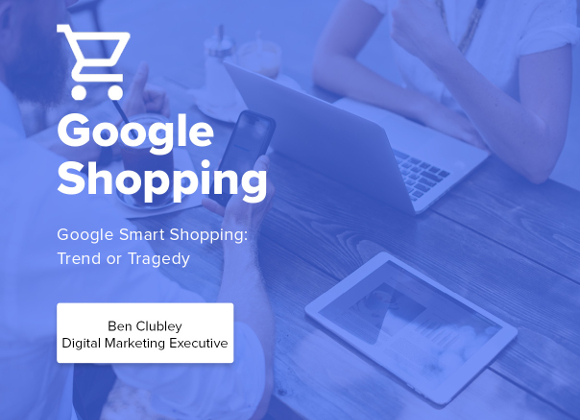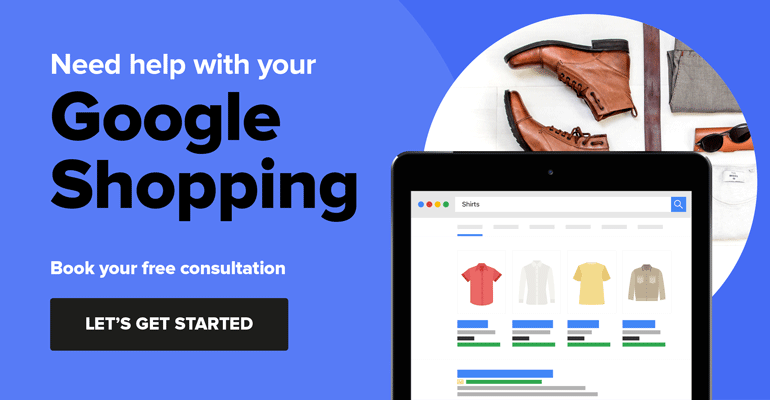Marketing spends on Google Shopping Ads surpassed Text Ads back in April 2017, and has since grown at a more rapid rate. It’s clear that Google Shopping Ads (also known as Product Listing Ads) are pivotal when it comes to the digital marketing of an eCommerce retailer.
“Google Shopping ads now drive 76.4% of retail search ad spend, generating 85.3% of all clicks on Adwords or Google Shopping campaign ads.” https://t.co/geDO6Fqvjk pic.twitter.com/9DYsJ1mA7f
— SmartInsights (@SmartInsights) August 21, 2018
Google have been pressing their latest toy ‘Google Smart Shopping’ for some months now, as they continue to morph their Google interface into a more AI dependent system.
In the current iteration, Smart Shopping calls the shots, using its algorithm based strategy to deliver results that you define during setup, by stating your target Return-On-Ad-Spend and Campaign budget. Smart Shopping does the rest. But is this all a little too good to be true?
Grab a drink, sit back. Let’s talk Google Smart Shopping.
What is Google Smart Shopping?
Google Smart Shopping is one of Google’s most important and heavily pushed features in recent times when it comes to Google Shopping. Google Smart Shopping aims to take machine-learning to the next level, by relinquishing your control to many features and giving it to the AI instead.
Google Smart Shopping uses both Shopping Ads and Display Ads (including remarketing and similar audiences), appearing on the Google Search Network, Display Network, YouTube and Gmail. Ads are created automatically, and placement is chosen based on past data, and then a bid is set in the effort to maximise your conversion value.
Requirements
There are certain requirements that must be met for you to be able to use Google’s Smart Shopping Campaigns.
You will, of course, need the essentials for any Shopping Campaign:
- A Google Ads account
- A Google Merchant Center Account
- A product data feed uploaded in your Merchant Center
- A conversion tracking tag on your website
You must also have had at least 20 conversions across your existing Google Shopping campaigns over the previous 45 days, With a remarketing audience list built with more than 100 users.
You must also ensure that you meet the general requirements and policies for Google Shopping campaigns and personalised advertising. Which can be found on the Google Support website.
Setting Up Smart Shopping Campaigns
Once you’ve reached all of the requirements you can set up your Smart Shopping campaigns like you would a normal Shopping campaign.
Google has now set Smart Shopping as the default campaign subtype during the setup as opposed to Standard Shopping, making it even easier to create your Smart campaign.
You will then be able to set a specific Return-on-Ad-Spend goal for the campaign. An example of this can be seen below.
You can then select specific products or product groups to advertise in your campaign, as well as upload assets such as logos, images and text if you are also looking to advertise on the Display Network.
Google also offers a walkthrough of setting up Smart Shopping campaigns on their Support site if you require further assistance.
What can you control within the campaign
A unique feature of Smart Shopping Campaigns is the amount of control you have over them. We will touch on this further into the blog, but the bottom line is that you don’t have very much control at all.
Once Smart Shopping is set up, the campaign budget, target ROAS, added products and assets such as your company logo and product images are the only editable aspects of the campaign. This means that everything else, from Device Modifiers to Product Bids are controlled by the AI, looking at various ‘signals’ to make informed decisions.
Pros & Cons
Smart Shopping is simple to set up, and simple to get going, but does that mean it is worth it? There is a wealth of pros and cons to help you make your mind up on whether Google Smart Shopping is as smart as it believes.
Pros
Smart Shoppings’ headline feature is that it is almost fully automated. Bids are changed, modifiers are adjusted and stats are analysed, all by an AI that is consistently learning. As the data grows, the Smart Shopping AI becomes more intelligent, making more qualified calls as time progresses. All the user needs to do during this is monitor performance, and adjust the changeable aspects within the campaign when deemed necessary.
This ultimately allows you to focus on other areas that may require the same, if not more attention, whilst machine-learning takes care of your account, whether that is all or some of your product set. Management is simple and takes very little time, which can be huge for those where time is limited.
Cons
The idea of little management time can seem alluring, and it sounds like the perfect tool to help one free up some time, however, Smart Shopping Campaigns also have a number of limitations and potential issues that may well be worth noting before setting one up.
Due to the use of various Networks such as Search and Display, reporting becomes difficult, and because of this, certain columns are omitted from reporting. These are as follows:
- Search Impression Share
- Search Abs Top IS
- Click Share
- Search Lost (Budget)
- Search Lost (Rank)
This means that separate reporting on each of the different Networks is also impossible. You cannot easily gain a full understanding as to what it is exactly that your Google Smart Shopping campaign is doing, leaving you in the dark.
There are many other omissions compared to a standard shopping campaign. Locations, Ad Scheduling, Device, Negative Keywords and Audience targeting are all affected, some more than others.
Locational Targeting: You can ONLY choose your country of sale. Specific Targeting and City exclusions are unavailable.
Ad Scheduling: Not Available
Device Targeting: Not Available
Negative Keywords: Not Available
Audience Targeting: Not Available (at least one list of at least 100 however must be available, but Google Smart Shopping will decide what to use based on machine-learning)
Shared Budgets: Guess what… Not Available
Integration with Google AdWords Editor is currently unavailable. This could change, however, once the AdWords Editor is updated, as there are still plenty of features missing from the software. This could greatly impact those who work with large accounts.
There is no doubt that Google Smart Shopping has its limiting factors, with reporting and your own edits being the two main issues. You cannot decide where your ads show, or where they show. You only have the power to change a couple of elements, but control is taken away from you.
There are positives, however, dependent on your current situation. Time is a hugely limiting factor, and the time you save with Automation on this scale is second to none. However, your trust must be placed into an Ai that has no human element, that is clearly not only working with your best interests in mind, but Google’s as well.
The Google Bot is always learning how to optimise, but how can a campaign be fully optimised if everyone is using Google Smart Shopping? Would this no longer make the Smart Shopping ‘Smart’?
One of the main reasons that people may be put off by Google Smart Shopping is the fact that they can no longer fully control the campaign, putting all of their trust in Google’s algorithms. As the Bee Gees famously sang,
“When you lose control and you got no soul – It’s tragedy”
But only time will tell.



